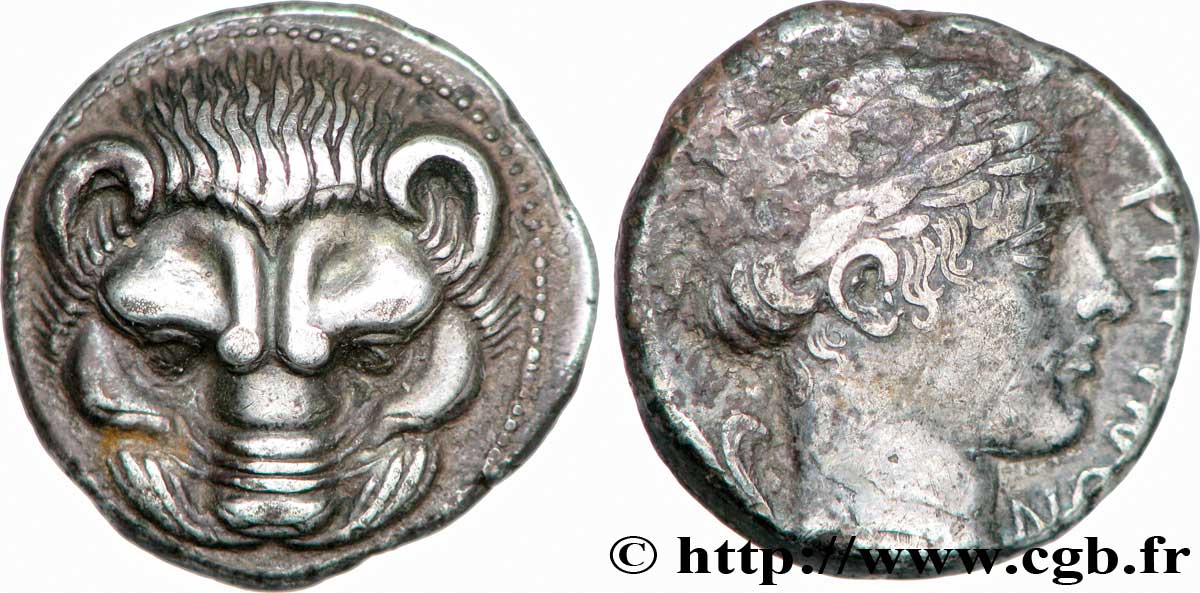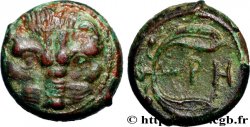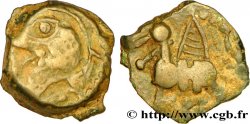v57_0012 - BRUTTIUM - REGGIO DI CALABRIA Tétradrachme
MONNAIES 57 (2013)
Начальная цена : 5 500.00 €
Назначить цену : 9 500.00 €
непроданный лот
Начальная цена : 5 500.00 €
Назначить цену : 9 500.00 €
непроданный лот
Тип Tétradrachme
Дата: c. 415/410 - 387 AC.
Монетный двор / Город: Rhégium, Bruttium
Металл: silver
Диаметр: 23 mm
Ориентация осей монеты: 6 h.
Вес: 16,91 g.
Редкость: R3
Комментарии о состоянии
Exemplaire sur un petit flan épais, parfaitement centré des deux côtés d’un style fantastique, de très haut relief avec un masque de lion extraordinaire, semblant sortir du flan. Revers finement détaillé de haut relief, un peu court sur la légende avec un visage expressif d’une émotion profonde et émouvante. Très belle patine de médaillier avec des reflets dorés
Ссылки в каталоге: :
Происхождение:
Cet exemplaire provient de la vente Vinchon du 17 décembre 1996, n ° 15
Лицевая сторона
Аверс: легенда: ANÉPIGRAPHE.
Аверс: описание: Masque de lion vu de face ; grènetis perlé circulaire.
Обратная сторона
Реверс: Описание: Tête laurée d’Apollon à droite, la chevelure élégamment disposée ; derrière un rameau d’olivier avec deux feuilles.
Реверс: легенда: RHGINON
Реверс: перевод: (de Rhégium).
Комментарий
Mêmes coins que l’exemplaire du Cabinet des médailles de la BnF, collection de Luynes, n° 794 et que l’exemplaire de la collection Valton, n° 108 que l’exemplaire de la collection Montagu (Sotheby, 1896), n° 81 que l’exemplaire du British Museum, collection Payne Knight et que celui du Fitzwilliam Museum de Cambridge (SNG. n° 849). C’est le dixième exemplaire recensé. Il pourrait s’agir de l’exemplaire signalé dans le commerce en 1949 (Dr. Jacob Hirsch), mais nous n’avons pas d’indication de poids. En dehors de l’exemplaire du British Museum qui pèse 16,76 g, tous les autres exemplaires ont un poids supérieur (entre 17,18 g et compris jusqu’à 17,40 g). Nous n’avons pas de liaison de coin avec d’autres exemplaires de la série. Il s’agit de l’ultime tétradrachme du classement de Herzfelder avant la destruction de la cité par Denys l’Ancien en 387 avant J.-C.
Same dies as the example in the Cabinet des médailles of the BnF, Luynes collection, no. 794 and the example in the Valton collection, no. 108, as the example in the Montagu collection (Sotheby, 1896), no. 81, as the example in the British Museum, Payne Knight collection and that of the Fitzwilliam Museum in Cambridge (SNG. no. 849). This is the tenth example recorded. It could be the example reported in trade in 1949 (Dr. Jacob Hirsch), but we have no indication of weight. Apart from the example in the British Museum which weighs 16.76 g, all the other examples have a higher weight (between 17.18 g and up to 17.40 g). We have no die connection with other examples in the series. This is the last tetradrachm in Herzfelder's classification before the destruction of the city by Dionysius the Elder in 387 BC.
Same dies as the example in the Cabinet des médailles of the BnF, Luynes collection, no. 794 and the example in the Valton collection, no. 108, as the example in the Montagu collection (Sotheby, 1896), no. 81, as the example in the British Museum, Payne Knight collection and that of the Fitzwilliam Museum in Cambridge (SNG. no. 849). This is the tenth example recorded. It could be the example reported in trade in 1949 (Dr. Jacob Hirsch), but we have no indication of weight. Apart from the example in the British Museum which weighs 16.76 g, all the other examples have a higher weight (between 17.18 g and up to 17.40 g). We have no die connection with other examples in the series. This is the last tetradrachm in Herzfelder's classification before the destruction of the city by Dionysius the Elder in 387 BC.








 Cообщить об ошибке
Cообщить об ошибке Распечатать страницу
Распечатать страницу Отправить мой выбор
Отправить мой выбор Задать вопрос
Задать вопрос Consign / sell
Consign / sell
 Информация
Информация













